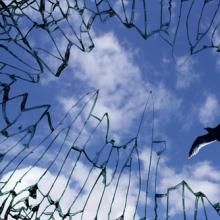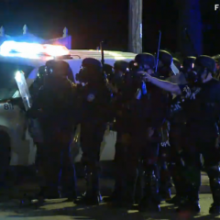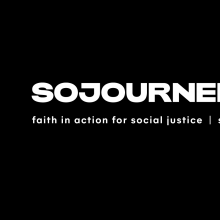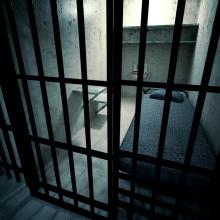racial justice
On a Sunday when the dominant color in Christian churches is pink — a symbol of joy for the third Sunday of Advent — I was wearing a black shirt, black pants, and a blue tie. Others in our congregation were wearing various combinations of black or blue.
This was a modest way of showing solidarity with African Americans and a reminder that “Black Lives Matter” while still showing empathy for the police in the Madison, Wisconsin, area who have worked hard over the years to have a diverse force that works to serve rather than dominate the varied racial and ethnic communities that exist here.
But even with a nod to the pressure police are under these days, the dominant focus was on the series of killings of unarmed black people. And we know that not all police departments have made the same efforts that have happened here over a generation — and that our police departments are not perfect either.
The movement to wear black on December 14 came from several African-American denominations across the nation. Here in Wisconsin, Rev. Scott Anderson, Executive Director of the Wisconsin Council of Churches, joined faith leaders in urging people to wear black to church on that Sunday.
The first time I really got it, I was 16 years old.
I had traveled by myself to visit distant relatives in Paris, with the hope of improving my French. Somehow, a weekend visit to the beach ended up with me on an unaccompanied trip on a train from a lazy seaside town back to the city. “I’m lonely here, God,” I thought. “Would you show me you are with me?”
Looking out the train window, there was a brilliant sunset hanging over the fields of canola flowers. There was my reminder of God’s love! As the train curved away from the sunset and it fell out of view, I sat back in my seat, satisfied with the gift I had been given … only to start up again as the train took a sharp curve to the left, the sunset back in full view.
“Oh,” I thought, “that’s what they mean by love being abundant and our cups overflowing. I get it.”
The first time I really got it, I was 18 years old.
On my first winter break back from college, I was driving in my parents’ car, listening to the radio. On air was a county executive discussing why a curfew might be a good idea for the county’s youth. According to him, instituting the curfew would help police arrest young people they suspected of other crimes. The implication was that it would only be enforced against those people who looked suspicious. Another voice on the show expressed concerns that what this meant was that the curfew would only be enforced against black teenagers.
“Oh,” I thought, “this is what they mean when they say the police target people they instinctively assume to be suspicious, even if they haven’t done anything wrong. I get it.”
“Excuse my ignorance, I thought I was a free black man.”
“I’m 11 [years old], I matter.”
“You can choose to look away, but never again can you say you didn’t know.”
“How many times do we have to protest the same [s**t]?”
“White silence is white violence.”
“We have nothing to lose but our chains.”
These signs, and many others, lined the horizon of Pennsylvania Avenue on Saturday in Washington, D.C. In a ‘Justice for All’ march organized by Al Sharpton and the National Action Network, thousands of protesters gathered to protest police actions that have resulted in the deaths of unarmed young black men across the United States.
After marching from Freedom Plaza to the U.S. Capitol, protesters listened to speakers from national racial justice organizations address some of these most recent acts of police brutality.
Al Sharpton sought to draw attention to the diversity present on the streets.
“This is not a black march or a white march. This is an American march for American rights,” he said.
Indeed, the black community was not alone in speaking up against police brutality. One Latina activist encouraged her Latino brothers and sisters to “voice their pain” from police harassment and “come forth and unify with the African American community so we can be strong together.”
“¡Ya Basta!” she concluded. [“Enough is enough!”]
Could it be that the crescendo of dissention is divinely synched to yet again heighten disruptive unease among the status quo? Could it be that the promise of Emmanuel — "God is with us" — as proclaimed by the heavenly host, but feared by powerful elite, is unavoidably linked through the eternal truth — such that even the Church universal cannot celebrate one and avoid the other? Could it be that through Advent, we are called to acknowledge the humanity and parity of personhood, rather than rest in the laurels of privilege? The anger of youthful Ferguson protests was marginalized and dubbed as riots, but could it be that this Advent response manifested in expanded multiethnic solidarity is of divine intent to raise challenge to elitism and to demand respect for people of color as equals rather than as patronized subordinates? Could it be that whether or not the media chooses to ignore the connection, the Advent message for those with ears to hear is that perpetrators of brutality, the comfortable protectors of privilege, and the self-serving pundits of power that tried to nullify the everlasting promise were unsuccessful then and now? Could it be by divine design that unknown names, stolen lives, are now divinely lifted to eternal and global recognition as sacrificial symbols so that truth could come to light?
It’s no secret that the prison population in the United States has exploded in recent decades. We incarcerate our citizens at higher rates than any other developed nation. The federal prison population has increased by almost 790 percent since 1980. The number of children with one or more incarcerated parents has increased at an astonishing rate of 80 percent since 1991.
The mass incarceration of mostly Black and Latino men and women has moral implications in two ways. First, our current “tough-on-crime” approach to criminal justice has cost taxpayers a substantial amount with little effect on crime rates. These tax dollars could be spent instead on education, mental health, or drug rehabilitation. The way we spend public money reflects our public values. (Sound familiar?)
In addition, there are far-reaching moral implications of the act of naming someone “criminal." This label is inhumane, unjust, and unholy.
The “criminal” label has devastating effects on quality of life and equality of opportunity for many individuals. It is nearly impossible to shake. Most federal education grants are not available to someone with a criminal background. In many cities, access to subsidized or public housing is banned based on arrests or incarceration. Many states ban those with criminal backgrounds from food stamp eligibility. Being forced tocheck the box on an employment application indicating a past felony conviction essentially lands that application in the trash. The Sentencing Project estimates a total of 5.85 million people have been banned from voting because of a past conviction.
But Christians have a unique, biblically-based perspective on labels. In Christ, “sinners” become “beloved ones." The excluded, hated, and oppressed become included, wanted, and loved.
In a township called Khayelitsha, a woman wakes well before dawn to catch a bus that will carry her to the beautiful home in Cape Town where her employer/boss/master wants his tea in bed by 7 a.m. That is what “post-apartheid” South Africa still looks like today.
I just returned from a remarkable month in South Africa—the country that changed my life. I’ve often said that I learned my theology of hope from South Africa, during the anti-apartheid struggle I was thrust into as a young man. South African church leaders invited me in years ago. I got to see and experience the costly movement for freedom in the 1980s, witness the miracle of the inauguration of Nelson Mandela’s rainbow nation in 1994, and later join a wonderful reunion of South African activists, many of whom had been in exile or in prison, along with some of us international allies. So when I set out on a South African speaking and book tour 20 years after the new democracy, I didn’t know what to expect.
This time, I brought my family so they could see the country that had meant so much to me. What I discovered was a new generation of South African leaders ready to define their own vocation and mission as they help build a new nation. I quickly came to understand that making a deep connection with them was the real reason that I had come back. It’s tough to be in the shadow of a heroic generation of leaders like Desmond Tutu whose agenda has been the political liberation of South Africa—accomplished to the amazement of the world. On this trip, 20 years later, I saw the incredible freedom of movement now for all the former racial categories—but also how the systemic geography of apartheid was still painfully evident.
Economic inequality in South Africa is now greater than it was even during the days of apartheid, and gender violence is rampant. So these are the new agendas of a new generation: economic liberation and gender equality, with a commitment to lead on both in the churches. The rainbow of young people who turned up in such great numbers at all of our events truly want a new South Africa— a society yet to emerge.
On the fourth morning after Michael Brown’s death, residents from different parts of the region came together to pick up the pieces.
Some were young, some old. The majority arrived as part of the faithful. Others trickled in after spotting volunteers marching up and down West Florissant under the hot sun. Carrying brooms and large garbage bags, they collected whatever they could find: rubber bullets, broken glass, liquor bottles, tear gas grenades.
“I needed to come out today just to get some stability,” said Gary Park, 34, an auto mechanic who lives near the area in Ferguson where Brown was shot and protests erupted. Close by is the looted and burned QuikTrip that sits as a symbol of the severity of the unrest that resulted from an unnamed cop fatally shooting an unarmed 18-year-old.
“I wanted some encouragement,” Park said.
Park is a member of Passage Community Church in Florissant, which together with a few other local congregations, organized the Wednesday morning cleanup. Pastor Joe Costephens said that although the trash-collecting effort was a last-minute plan, more than 100 people joined the endeavor.
It was a simple act but not an insignificant one, especially since authorities reported two shootings only the night before. In fact, the continued violence has put future volunteer efforts on hold, Costephens said.
In my pastoral counseling class in seminary, the professor played a video of a counseling session of a black couple. He intended for us to learn some lessons on marriage counseling from it, but it turned out to be a laugh fest for the mostly white class. Repeatedly the husband and wife cut each other down with witty insults. My sense is that the couple reminded the students of George and Louise Jefferson from the TV show The Jeffersons. I sat next to an African American student that day and during the break I turned over to him and asked, “Do you find this funny?” He said, “I’m glad you asked,” and proceeded to tell me that he witnessed this kind of behavior firsthand in his own home since his parents are divorced. Needless to say he did not find the video amusing. I encouraged him to voice this to the class, which he courageously did when we returned from break. It seems while the professor intended to communicate one thing from showing the video, it communicated another because of the manner in which the students were racialized.
I share this story as an analogue to the recent controversy surrounding the production of the Seattle Gilbert and Sullivan Society’s The Mikado — a comic opera written in 1885 as a critique of British politics and institutions, set in distant, mysterious, and mostly made-up Japan. It began with Sharon Chan writing an editorial to the Seattle Times, calling the current production of it by an all-white cast as “yellowface” and “open[ing] old wounds and resurrect[ing] pejorative stereotypes.” Since then, Jeff Yang has also written an editorial for CNN.com entitled, “Yellowface staging of ‘The Mikado’ has to end.” I will not rehearse their arguments here; I write to address why this incident matters to North American evangelicals.
AFRICAN AMERICANS around the country are finding it is dangerous to call 911. Jack Lamar Roberson’s family in Waycross, Ga., discovered this the hard way when they placed an urgent call to 911 in October 2013 because his fiancée thought that he had taken an overdose of diabetes medicine.
Instead of sending EMTs, the dispatcher sent the police. Within 20 seconds of being in the house, police shot Roberson nine times, with bullets striking his back, arms, chest, and head as he held his arms up in the air. Although he was a veteran, he did not die from bullet wounds at the hands of strangers in a foreign land. Instead, white police gunned him down in his home.
Killings like this—which could be called anti-black hate crimes by police—are far too common. “Operation Ghetto Storm,” a 2012 report by the Malcolm X Grassroots Project, revealed that white police officers, security guards, or vigilantes kill an unarmed black man, woman, or child every 28 hours in the U.S. In 2012, police officers shot 57 people in Chicago—50 were black, two were white. Miami police officers killed seven black men within eight months in 2011. The Houston-based African-American News & Issues headlined an article this spring: “Open Season on Blacks in Texas: Cops Are Shooting First & Not Asking Questions.”
These police killings of black people emerge out of a culture and system of white supremacy. In such a context, police killing of black people is not a black problem. It is an American problem that shreds the curtains of democracy.
My sister has one of those plastic playhouses in her backyard for her two boys. When she hosted a garage sale a few years ago, children accompanying their shopping parents would see the playhouse and join in.
I remember looking over at one point and seeing five children playing together. Different ages, different sexes, different races. All strangers. All playing together.
When they looked at each other, they saw a playmate.
In his autobiography, Nelson Mandela noted that children have an innate openness that tends to get closed off as they spend more time in the world.
“No one is born hating another person because of the colour of his skin, or his background, or his religion,” Mandela wrote in his autobiography. “People must learn to hate, and if they can learn to hate, they can be taught to love, for love comes more naturally to the human heart than its opposite.”
Sometimes it is hard to know even where to begin. We stare at this System, this complex web of human behaviors, and the institutions erected to memorialize them, and we simply do not know where to begin. How do we fix it?
"That's just the way it is," we say. "Some things will never change."
Systems are strange beasts. They take incredible human investment to maintain. They are the spaces by which many of us come to know ourselves, to know our place in this world. We identify ourselves in relationship to them. And yet they are so close to us as to be rendered invisible.
Until they hurt us. Until they step on us, exclude us, enslave us, brutalize us.
And this is when it gets interesting, of course; this is when they do their real work, these systems.
There is a moment in John Steinbeck’s classic, East of Eden, when readers witness the transformation of a stereotype into a human being.
Set in Salinas Valley, Calif., around the turn of the 20th century, Samuel Hamilton picks up Lee, his friend's Chinese servant. Lee wears a queue and speaks Pidgin English. Moments after meeting him, Hamilton learns that Lee was born in the U.S. and asks why he still can’t speak English.
Lee’s face and eyes soften and he speaks perfect English, explaining that he speaks Pidgin for the whites in town to understand him. Lee says, “You see what is, where most people see what they expect.”
Did you catch that? Lee plays the role of the foreigner in order to be seen and understood.
What more perfect a passage to enliven our Earth Day celebrations than Romans 8:20-25?
Paul's letter to the Romans was certainly not an exhortation to deepen creation care by weighting it with environmental justice. It wasn't an exhortation for the middle-class church to listen to the groaning of people under the bondage of environmental racism. It wasn't intended to paint a picture of the intersection of climate change, poverty, and racism.
But we — two evangelical activists — are just foolish enough to give all that a try in this short space!
Our dear Apostle Paul in his letter to the Romans paints a picture of the new age inaugurated by Jesus' death and resurrection. Jesus has taken sin – that which infiltrated the world (5:12), enslaved the world (6:6, 17-18), and brought death and destruction (7:8-14) — and had victory over it. By our death in baptism and resurrection with Christ, we participate in his victory over sin (6:4). This is a new age, we put on our new selves, we live with the (re)new(ed) creation ahead of us.
ONE RECENT WINTER day, Nora Howell stepped out of her house in the Sandtown neighborhood of Baltimore and took a walk down the street. People in the predominantly black community did double takes as this white woman promenaded past them in a sundress made of saltine and oyster crackers. Some stared in disbelief. One man doubled over laughing. In the corner coffee shop, one of the regulars warned Howell not to walk by any homeless people because they might just eat her up.
Later Howell, a community artist and director of the neighborhood Jubilee Arts program, set the video footage taken during her walk to Mister Rogers’ classic refrain, “Won’t You Be My Neighbor?” The piece, which emerged out of Howell’s ponderings on what it means to be white living in a black neighborhood, became another part of her answer to a call: to use art to address systemic racism and bring about the kingdom of God.
From Race Riots to White Suburbia and Beyond
In 2001, Howell was an eighth grader living in a biracial community in urban Cincinnati. When race riots erupted after a young black man was shot fatally by a white police officer (sound familiar?), her family took to the streets on a prayer walk through the riots. Howell remembers being shocked and terrified, thinking, “Why do we still have race riots? Cincinnati is so far behind the times.”
In the aftermath, Howell talked with peers at school on the reality of racial tensions and observed with curiosity how white and black churches throughout the city responded. She realized race riots weren’t just a relic of the ’60s. “When you lived in a place where different racial groups interacted daily, [racial tensions] could no longer be denied or ignored,” she said.
Yet when Howell moved to suburban Chicago to attend Wheaton College, conversations on race were largely absent. “I found that very odd,” she said. She got involved in a campus group to promote awareness of racial injustice.
There are so many people that have gone before me, people that have sacrificed their lives in pursuit of justice and equality. Because of this, I feel a deep sense of commitment to honor them by standing for some of the same things that they did. I am in complete awe of two things that connect deeply for me. The first is the cross and how Jesus gave his life for us all. The second is my ancestors who somehow understood Jesus’ sacrifice and passed it onto me through intense persecution.
I can’t say that I know persecution like my parents, grandparents, and great-grandparents knew. I have been back to southern Alabama many times for family reunions and visited slave graveyards where relatives are buried. This compels me to be and do more with my life. I can’t say I understand why Jesus would choose to become human, walk this earth as a human being, and then die at the hands of his own creations to save those who were crucifying him. However, I do know it pushes me to be and do more with my life. I feel like I would let them down somehow if I didn’t take responsibility for addressing injustice with my life.
My life is not my own. I am the product of sacrifice. I am here because of those who saw beyond themselves and thought personal sacrifice was worth giving up to allow justice to take hold. I am here because Jesus modeled something completely illogical on the cross and then some of my ancestors took that example seriously and repeated it. I have no real right to the life I live. My only recourse is to continue the tradition handed to me in the same way.
In the short three months that I have been at Sojourners as the director of individual giving, I’ve been humbled and inspired by the countless social justice activists who make up our community. In these three months, I have witnessed activism for immigration reform, a vigil for those most affected by congressional dysfunction, organizing for climate change, a prophetic stand for racial justice, the launching of a new campaign to empower women and girls, and much more.
Adaptation is how a bitter and broken South survived its own worst instincts after the war. Progressive pockets emerged in college towns and later in large cities. Hungry for Northern business, the region became less racially polarized. In time, a black man could become mayor of Atlanta and another could become the Episcopal bishop of North Carolina.
The Rev. Martin Luther King, Jr.’s dream of 50 years ago came to seem possible. Distant, yet possible.
But now the dream has receded. The fact of a black president seems to have reopened a pulsing vein of racism. Operating under cover of fiscal austerity, vengeful state politicians are gutting decades of programs that helped the South move forward by helping blacks and Latinos to have a chance.
No more affirmative action, they say; no more dark-skinned citizens flocking to voting stations; no more voting districts shaped by fairness; no more protections from ground-level aggression against people of color.
Once again, as happened in the 19th century, impoverished whites who should be lining up to resist predatory behavior by the moneyed class are being turned against their own best interests by race politics.
It all sounds so… demanding. Sell your possessions and give to the poor. “Be dressed for action." Imagine yourselves as slaves who remain ready for their master’s return — not knowing when it might come.
Luke’s Gospel is big on demanding. In Luke 9:57-62, Jesus encounters three would-be disciples. And each receives a warning that would vanquish enthusiasm like an ice-cold shower.


















